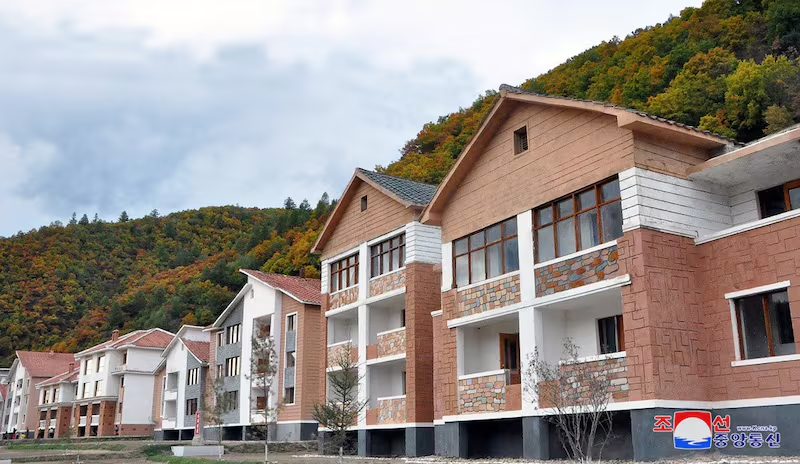North Korea is building free homes for people in the countryside, but the homes are impractical for the realities of rural life, residents told Radio Free Asia.
A total of 650 homes were newly built between July and September in the mountainous northern province of Ryanggang. Some of the homes are individual one-story homes, but others are units in two or three-story apartment buildings.
State media, as usual, aired propaganda-laced reports showing happy residents moving in on Oct. 5, but their smiles quickly turned to frowns once the cameras were turned off, residents said.
Specifically, many of the apartments have thin, concrete walls that are cold in the winter, not brick-and-mud, which are thicker and provide better insulation. They also lack gardens for growing vegetables or places to keep animals, which is very common among rural families.
Plus, none of the homes have running water.
“The newly built homes are an urban style that completely ignores the conditions of rural areas,” a resident of the province, who requested anonymity for personal safety, told RFA Korean. “There are many complaints from residents who have moved in.”

Simply plopping a three-story city-style apartment building next to a collective farm does very little for the people who have to live there, he said.
“A rural home must have a large garden and space to raise animals,” the resident said. “The new rural homes built on cooperative farms across the country are usually two or three stories … and have very little consideration for personal gardens or livestock farming space.”
Gift from the nation
It isn’t just anyone who can move into these new homes. Only men who finished their seven- to 10-year mandatory military service between 2019 and 2022 and who recently married were eligible to be awarded the home.
A shortage of homes in the rural areas means that many young people with families have had to shack up with their parents or siblings, so many jumped at the chance to move into the new ones, the resident said.
Some of them may be singing a different tune come winter, when temperatures can plunge to minus 36 degrees Celsius (minus 33 Fahrenheit), another resident told RFA.
Winter chills
“The two-story and three-story apartments were built with cement, while the one-story houses were built with mud bricks and plastered with mud,” he said. “Those who received an apartment were not happy, while those who received a single-story house looked fortunate.”
To make matters worse, the concrete apartments have thin walls. It is normal for homes in the area to have exterior walls that are 50 centimeters (about 20 inches) thick, but the apartment walls are between 35 to 40 centimeters (around 14 to 16 inches) thick.
“Apartment houses built with cement have a low thermal insulation effect, so they cannot withstand the cold in winter,” he said. “It is also inconvenient for gardening or raising domestic animals.”
In addition to the space and temperature problems, none of the homes have running water, the second resident said.
“There are water pipes and a toilet in every house, but there is no actual water network or water source,” the resident said, adding that there’s not even a plan to connect the homes to a water system at a later date.
“So having water pipes and a toilet in the house does nothing,” he said. “The first thing the residents did after moving in was to get drinking water from the nearby stream.”
Translated by Claire Shinyoung Oh Lee. Edited by Eugene Whong and Malcolm Foster.
